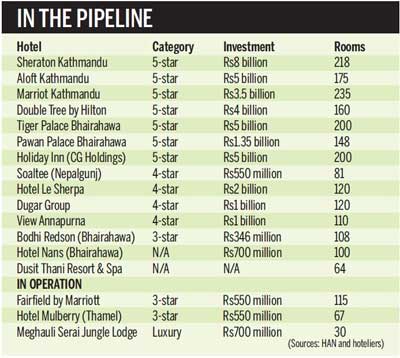

New hotels worry old players

Nepal is seeing an unprecedented boom in hotel construction that will add 4,000 star category rooms by 2020. The building spree has spread concern among the existing hoteliers who fear that the new entrants will eat into their markets.
Last Friday, Hotel Association Nepal (HAN) issued a ‘white paper’ urging the government to rein in the overheated hotel sector. The apex body of the country’s hotel industry has asked the government to assess the demand and supply of hotel rooms and raise the criteria for hotel expansion.
“We should be careful that these new hotels create more demand for the additional supply of rooms rather than competing over prices and replacing good old hotels,” states the white paper. “If these hotels go out of business, banks which have invested heavily in the sector will have problems and it will eventually hurt the economy.”
Former HAN president Yogendra Sakya said that new investments in the hospitality industry was good, but excess capacity would generate low priced and low quality. The concerns of established hotels are different from those of newcomers.
“If new hotels suffer, it will ultimately affect banks and the financial sector. But if old hotels suffer, it will affect investors, not banks. There are many instances from the past of how reputed hotels went bankrupt on low demand,” he said.
Another problem is sustainability of hotels. Shakya said that hotels currently spend almost 40 percent of their revenues on paying staff salaries against the international average of 10-15 percent.
“For instance, one reputed hotel in Kathmandu earns Rs1 billion annually. Out of this income, 40 percent goes into paying the employees and the hotel is left with an annual profit of less than 7 percent,” he said, adding that this was less than what could be earned by simply depositing the money in a bank.
HAN President Amar Man Shakya said that more than Rs250 billion had already been invested in the hotel sector that provides 500,000 jobs.
Many other sectors may have suffered from a resource slowdown, but the new supply of hotels has triggered a new beginning in tourism highlighting the optimism in the industry, he said.
“We all know that more than 4,000 rooms are being added in the industry in the next two years. To safeguard the investment, we have no option but to increase the number of tourists,” he said.
According to HAN, the registered hotels in Nepal currently produce 13.96 million bed nights annually. The average occupancy rate of hotels is estimated to be around 70 percent. A dozen hotels are injecting more than Rs40 billion into the industry.
HAN’s white paper says that the advent of reputed international hotel chains is expected to enhance Nepal’s image, but some hoteliers are concerned that excess supply may intensify competition in the already highly charged hotel market.
“If the number of tourists or demand for rooms does not rise proportionately, there will be a fierce price competition between old players and new entrants,” states the white paper.
But these challenges can be translated into opportunities, says President Shakya. “We have a huge outbound tourism market in India and China,” he said. The number of China’s outbound tourists reached 122 million in 2016. India is estimated to generate 6.5 million outbound luxury tourists annually by 2020.
The tourism sector has a high growth potential among all areas, and as a result, it has been attracting investors, said Min Bahadur Shrestha, vice-chairman of the National Planning Commission.
“The hotel industry has been showing a good sign. The tourism sector could lead the way in Nepal’s economy delivering economic and job growth.”
He added that Nepal had not been able to attract tourists as per its potential due to infrastructure bottlenecks, and for this reason, tourism’s contribution to the GDP had remained very small.
The expansion of Tribhuvan International Airport and enhancing Gautam Buddha Airport into an international airport, besides the development of two new international airports, will be vital to increase tourist growth, he said.
“As Nepal Airlines Corporation has been stymied by lack of growth, we have not been able to generate revenues as expected,” he said, adding that the government had accorded priority to boosting the fleet of the national flag carrier.
source:SANGAM PRASAIN, The kathmandu post, 11 July 2017








